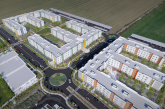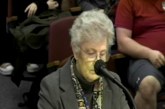
The city council has discussed what a General Plan Update process would look like and, after discussing the issue preliminarily in July, staff has returned with a plan that would initiate the Core Area policy and code amendments first, which has some overlap with a General Plan Update before starting the General Plan Update.
It is anticipated that this would take between three and three and a half years to fully complete.
Staff recommends this approach, as focusing first on the Core Area would allow the city to develop a vision and address the recurring challenges in the Core Area. Second, it would allow making substantial progress toward Core Area policy/code amendments before embarking on a citywide General Plan update. And third, it would use the Core Area visions and preferred alternatives as guides for the General Plan Update.
Staff then lays out a resolution including the following directions:
- Form based code approach. A primary objective of this planning effort is to consider the approaches, principles and components commonly associated with form based codes. The approaches include: creating a detailed vision for the kind of place the community desires; addressing both private and public space design to create a whole place; and then drafting and implementing a code to implement the vision. The extent of amendments to existing plans, policies, codes and guidelines shall be determined through the planning process.
- Improved guide for long term policy decisions and development. A primary objective of the plan is to provide an improved long term framework for policy decisions and to anticipate future physical development consistent with the vision and the implications of such development.
- Guide for infrastructure. A primary objective of this planning effort is to address the adequacy of infrastructure with future growth and development, and to provide a guide for long term infrastructure needs, priorities and investments.
- Address recurring problems. Another primary objective of this planning effort is to resolve or reduce recurring problems with the implementation of existing Core Area policies, codes and guidelines.
- Implementation tools to be determined. This planning effort does not pre-conceive or pre-determine the planning tools that should implement the vision or address the recurring problems.
- Clearer and more concise. The objective is to make Core Area policies and codes more clear, concise and user friendly for owners/applicants, staff, neighbors, commissions and City Council.
- Creative. An objective for the plan is to be innovative and creative with advanced and original aspects.
- Maintain timeline and budget. The intent is to retain a timeline and budget constraints.
- Time horizon. The preliminary time horizon of the plan, the period over which the plan and its implementation would be most relevant, shall be 20 years which could be January 2040 assuming the plan is adopted in December 2019.
- Processing of development applications during the General Plan update. After the Core Area policy/code amendment update begins (defined as the authorization of the consultant team to proceed), staff will generally continue to process all new development applications. Staff is granted the ability, however, to seek Council’s direction on whether to process new development applications that involve changes of land use designation or zoning.
- Community engagement. The objective is to effectively and efficiently engage the community to inform, seek input and obtain comments using techniques appropriate to the objective at the stage of the update process. Community engagement is anticipated to include but not be limited to: on-line information and surveys; public forums and workshops; formation of a Core Area Advisory Committee (CAAC) with open meetings; and public meetings at key stages at the Planning Commission and City Council. The preliminary scope of community outreach shall be identified in the RFP (Requests for Proposal) by City staff requesting that the consultant teams propose how they would vary and the costs. Community engagement in Core Area visioning is a major component early in the process.
- Advisory committee. The CAAC is anticipated to be the primary advisory body to the City Council. The CAAC is intended to provide high level policy input, represent the entire Core Area community as well as their individual interests, and understand the points of view of others.
- Roles of the different parties. The roles of the different parties in the update process including the City Council, CAAC, staff, consultant, Planning Commission, other City commissions, and community members shall be addressed in the RFP by City staff.
- Background reports/information. The responsibilities for the compilation of background reports/information and analyses of existing conditions/trends by staff and the consultant team shall be identified in the RFP by City staff.
—David M. Greenwald reporting






I am very supportive of an update of the General Plan and appreciate the effort that has and will go into this endeavor.
“Staff is granted the ability, however, to seek Council’s direction on whether to process new development applications that involve changes of land use designation or zoning.”
However, if, in addressing “changes of land use designation or zoning” the staff is only “granted the ability”, not mandated, to seek Council’s direction, I can see much of the same dynamic of approval by exception and subsequent prolonged opposition up to and including lawsuits that we currently see to the detriment of all. I would love to see the update help us to move beyond this oppositional structure that has evolved in Davis.
The way it generally works, Tia, is that staff notifies CC that an application (that fits the criteria involves GP or zoning changes) has been made, giving them an opportunity to call it up, discuss, and then direct staff as they see fit. If staff sees that there are significant issues, they’d generally ‘flag’ those, and might even recommend that CC direct staff to cease processing (effectively a denial) of one or more applications.
If CC does not call it up, discuss, and direct, the assumption would be that CC is either directing staff to process, or perhaps concurring with a staff recommendation to cease processing…
hpierce
Then perhaps I am simply not understanding how the paragraph I quoted represents a change from current usual process. My understanding was that the proposed process would make it optional rather than obligatory for staff to bring this to the attention of the CC early in the process. Am I misreading ?
You used the word “optional”, as in it was up to staff in their sole discretion, and “mandatory” — HAVE to DO… I see no change proposed in the “best management practices” used since say 25 years ago… worded it the way I did, as although I know of no exception in that time, I cannot personally verify it was done 100% of the time. Pretty sure it was on a 95-99% confidence level.
Think you missed the context that the report’s author was addressing, or I did. Am pretty sure, knowing the Planning division, that I got it right. No plan to change that there is no new SOP proposed.
Besides you, thought it would be good for the ‘larger’ audience to understand how it currently works. I criticized you not. My sole purpose was education, not refutation. If you took it as the latter, tough. Not my problem.
On first reading, the proposed changes appear to be beneficial. Even if these changes are implemented, however, the process will never ‘move beyond this oppositional structure’ until the anti-change zealots in town stop being oppositional. Changing the process will have no impact on this opposition as they will just find another reason to complain. The problem is not our current process or the proposed changes, it is that both past and current councils have attempted to appease the ‘noisiest’ in the room instead of following a professional process that focuses on the benefits for the entire City.
Mark
“Changing the process will have no impact on this opposition as they will just find another reason to complain.”
I realize that this is your point of view. However, I think that there is ample evidence that your statement is not correct. Many people had objections to aspects of The Cannery as initially proposed but dropped their opposition in view of mitigations on the part of the developers. Paso Fino also arrived at a compromise solution. I do not believe that most of those who oppose projects do so as a matter of unyielding “principle” to stop all growth, but rather as a genuine desire to improve projects that have significant downsides for those most affected. Trackside is a third and ongoing example in which there would have been no significant opposition had the project adhered to the zoning and design guidelines as has been made clear to the city and developers on multiple occasions.
I am aware that this is a point on which we will likely have to agree to disagree. However, I was willing to provide examples of why I believe that your statement as written is incorrect, and would be open to hearing your evidence in support of your assertion.
hpierce
“Besides you, thought it would be good for the ‘larger’ audience to understand how it currently works. I criticized you not. My sole purpose was education, not refutation. If you took it as the latter, tough. Not my problem.”
I understand and agree with your attempts at education, both of me and the general audience.
Right up until this point, I had taken nothing at all as criticism nor refutation. In the above last two sentences, I see nothing but needless aggression. Again, not your problem. But hardly conducive to a civil and educational conversation which I believe to be the goal.
That’s not how I read the tone of your earlier post. Perhaps, my error.
Yet, “I see nothing but needless aggression.”, would indicate that you are considering my ‘intent’ as “aggression”. If it was (it wasn’t), it would indeed have been needless.